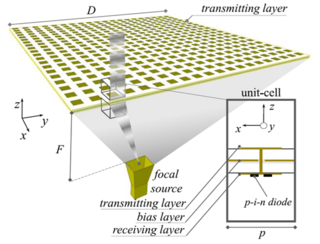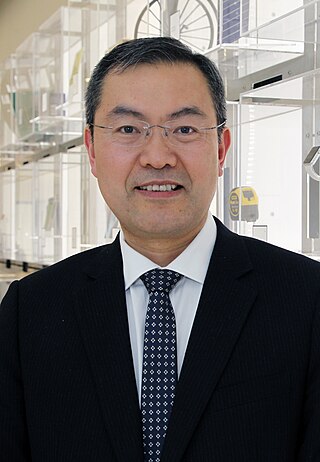Related Research Articles

In electrical engineering, a circulator is a passive, non-reciprocal three- or four-port device that only allows a microwave or radio-frequency (RF) signal to exit through the port directly after the one it entered. Optical circulators have similar behavior. Ports are where an external waveguide or transmission line, such as a microstrip line or a coaxial cable, connects to the device. For a three-port circulator, a signal applied to port 1 only comes out of port 2; a signal applied to port 2 only comes out of port 3; a signal applied to port 3 only comes out of port 1. An ideal three-port circulator thus has the following scattering matrix:

A waveguide is a structure that guides waves by restricting the transmission of energy to one direction. Common types of waveguides include acoustic waveguides which direct sound, optical waveguides which direct light, and radio-frequency waveguides which direct electromagnetic waves other than light like radio waves.

Microstrip is a type of electrical transmission line which can be fabricated with any technology where a conductor is separated from a ground plane by a dielectric layer known as "substrate". Microstrip lines are used to convey microwave-frequency signals.

A Vivaldi antenna or Vivaldi aerial or tapered slot antenna is a co-planar broadband-antenna, which can be made from a solid piece of sheet metal, a printed circuit board, or from a dielectric plate metalized on one or both sides.
A dielectric resonator antenna (DRA) is a radio antenna mostly used at microwave frequencies and higher, that consists of a block of ceramic material of various shapes, the dielectric resonator, mounted on a metal surface, a ground plane. Radio waves are introduced into the inside of the resonator material from the transmitter circuit and bounce back and forth between the resonator walls, forming standing waves. The walls of the resonator are partially transparent to radio waves, allowing the radio power to radiate into space.

Linda Pisti Basile Katehi-Tseregounis is a Greek-born American engineering professor and former university administrator. Katehi was elected a member of the National Academy of Engineering (2006) for contributions to three-dimensional integrated circuits and on-wafer packaging and to engineering education. Katehi worked as the University of Illinois Urbana-Champaign's provost from 2006 to 2009 and dean of engineering at Purdue University from 2002 to 2006. Beginning in 2009, she served as the sixth chancellor of the University of California, Davis.

Metamaterial antennas are a class of antennas which use metamaterials to increase performance of miniaturized antenna systems. Their purpose, as with any electromagnetic antenna, is to launch energy into free space. However, this class of antenna incorporates metamaterials, which are materials engineered with novel, often microscopic, structures to produce unusual physical properties. Antenna designs incorporating metamaterials can step-up the antenna's radiated power.
A reconfigurable antenna is an antenna capable of modifying its frequency and radiation properties dynamically, in a controlled and reversible manner. In order to provide a dynamic response, reconfigurable antennas integrate an inner mechanism that enable the intentional redistribution of the RF currents over the antenna surface and produce reversible modifications of its properties. Reconfigurable antennas differ from smart antennas because the reconfiguration mechanism lies inside the antenna, rather than in an external beamforming network. The reconfiguration capability of reconfigurable antennas is used to maximize the antenna performance in a changing scenario or to satisfy changing operating requirements.
Robert Emmanuel Collin was a Canadian American electrical engineer, university professor, and life fellow of the IEEE, known for his fundamental contributions in applied electromagnetism.
Debatosh Guha is an Indian researcher and educator. He is a Professor at the Institute of Radio Physics and Electronics at the Rajabazar Science College, University of Calcutta. He is an Adjunct faculty at the National Institute of Technology Jaipur and had also served Indian Institute of Technology Kharagpur as HAL Chair Professor for a period during 2015-2016.

Weng Cho Chew is a Malaysian-American electrical engineer and applied physicist known for contributions to wave physics, especially computational electromagnetics. He is a Distinguished Professor of Electrical and Computer Engineering at Purdue University.

A transmitarray antenna is a phase-shifting surface (PSS), a structure capable of focusing electromagnetic radiation from a source antenna to produce a high-gain beam. Transmitarrays consist of an array of unit cells placed above a source (feeding) antenna. Phase shifts are applied to the unit cells, between elements on the receive and transmit surfaces, to focus the incident wavefronts from the feeding antenna. These thin surfaces can be used instead of a dielectric lens. Unlike phased arrays, transmitarrays do not require a feed network, so losses can be greatly reduced. Similarly, they have an advantage over reflectarrays in that feed blockage is avoided.

A reflectarray antenna consists of an array of unit cells, illuminated by a feeding antenna. The feeding antenna is usually a horn. The unit cells are usually backed by a ground plane, and the incident wave reflects off them towards the direction of the beam, but each cell adds a different phase delay to the reflected signal. A phase distribution of concentric rings is applied to focus the wavefronts from the feeding antenna into a plane wave . A progressive phase shift can be applied to the unit cells to steer the beam direction. It is common to offset the feeding antenna to prevent blockage of the beam. In this case, the phase distribution on the reflectarray surface needs to be altered. A reflectarray focuses a beam in a similar way to a parabolic reflector (dish), but with a much thinner form factor.
Roger Fuller Harrington is an American electrical engineer and professor emeritus at Syracuse University. He is best known for his contributions to computational electromagnetics with his development of method of moments (MoM). Harrington's 1968 book, Field Computation by Moment Methods, is regarded as a pivotal textbook on the subject.
Yuen Tze Lo was a Chinese American electrical engineer and academician. He was a professor emeritus at the Department of Electrical and Computer Engineering at University of Illinois at Urbana–Champaign. He is best known for his contributions to the theory and design of antennas. He is the editor of the textbook series, Antenna Handbook.

The method of moments (MoM), also known as the moment method and method of weighted residuals, is a numerical method in computational electromagnetics. It is used in computer programs that simulate the interaction of electromagnetic fields such as radio waves with matter, for example antenna simulation programs like NEC that calculate the radiation pattern of an antenna. Generally being a frequency-domain method, it involves the projection of an integral equation into a system of linear equations by the application of appropriate boundary conditions. This is done by using discrete meshes as in finite difference and finite element methods, often for the surface. The solutions are represented with the linear combination of pre-defined basis functions; generally, the coefficients of these basis functions are the sought unknowns. Green's functions and Galerkin method play a central role in the method of moments.
Georges Armand Deschamps was a French American engineer and Professor Emeritus at the Department of Electrical Engineering at University of Illinois at Urbana-Champaign. He is best known for his contributions to electromagnetic theory, microwave engineering and antenna theory. He is also regarded as an early pioneer of microstrip and patch antennas, which he proposed in 1953.
Arthur Aaron Oliner was an American physicist and electrical engineer, who was professor emeritus at department of electrical and computer engineering at New York University-Polytechnic. Best known for his contributions to engineering electromagnetics and antenna theory, he is regarded as a pioneer of leaky wave theory and leaky wave antennas.
Nacer E. Chahat is a French Algerian-American engineer and researcher at the National Aeronautics and Space Administration (NASA) Jet Propulsion Laboratory.

Yang Hao is an electrical engineer, academic, and author most known for his research in wireless connectivity and metamaterials. He is the holder of the QinetiQ/Royal Academy of Engineering (RAE) Research Chair, and serves as the Director of both the EPSRC Research Centre on Future Wireless Connectivity and the EPSRC Centre for Transformation Optics and Metamaterials. He is also a Professor of Antennas and Electromagnetics, and Deputy Vice Principal for Strategic Research at Queen Mary University of London (QMUL). He is a Co-Founder and Director of AOTOMAT, and co-founded a satellite communication company called Isotropic Systems.
References
- ↑ Pozar, David M. (1980). On moment method solutions for plate and wire geometries (PhD). Ohio State University.
- 1 2 Pozar, D.M. (January 1992). "Microstrip antennas". Proceedings of the IEEE . 80 (1): 79–91. doi:10.1109/5.119568.
- 1 2 3 Kwon, Do-Hoon; Pozar, David M. (December 2009). "Optimal Characteristics of an Arbitrary Receive Antenna". IEEE Transactions on Antennas and Propagation . 57 (12): 3720–3727. Bibcode:2009ITAP...57.3720K. doi:10.1109/TAP.2009.2025975. S2CID 39725234.
- 1 2 Pozar, D.M.; Targonski, S.D.; Syrigos, H.D. (February 1997). "Design of millimeter wave microstrip reflectarrays". IEEE Transactions on Antennas and Propagation . 45 (2): 287–296. Bibcode:1997ITAP...45..287P. doi:10.1109/8.560348.
- ↑ Pozar, David. "A Review of Aperture Coupled Microstrip Antennas" (PDF). Electrical and Computer Engineering University of Massachusetts at Amherst. CiteSeerX 10.1.1.535.4686 .
- ↑ Pozar, David (1987). "Increasing the bandwidth of a microstrip antenna by proximity coupling". Electronics Letters. 23 (8). Electronics Letters, Institute of Electrical Engineering: 368. Bibcode:1987ElL....23..368P. doi:10.1049/el:19870270.